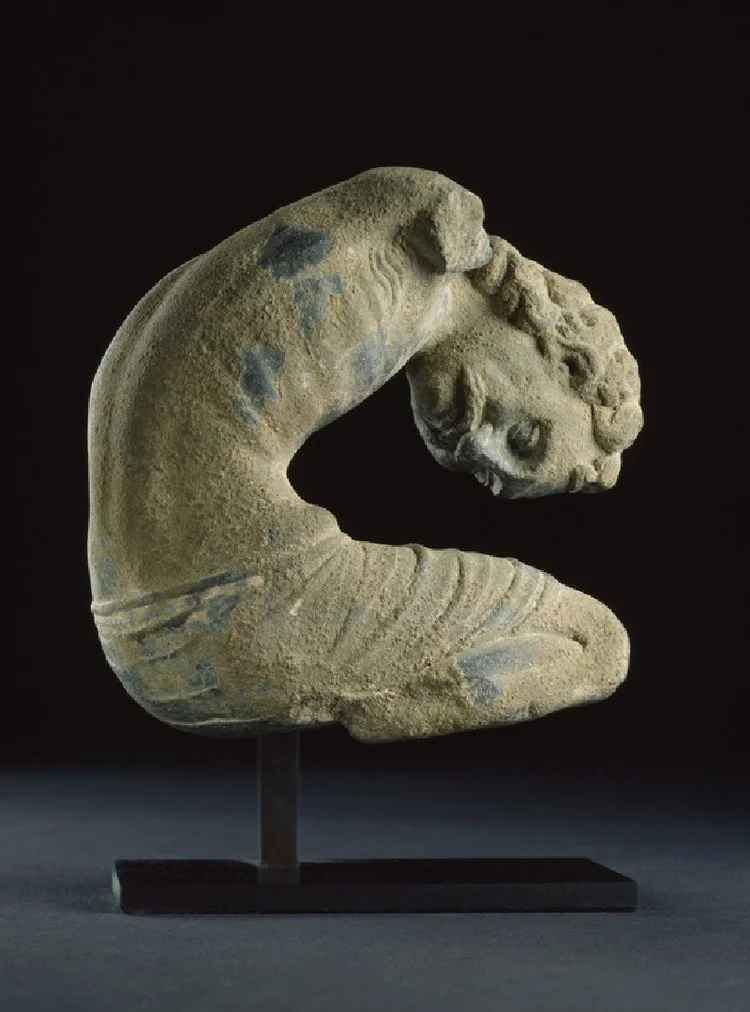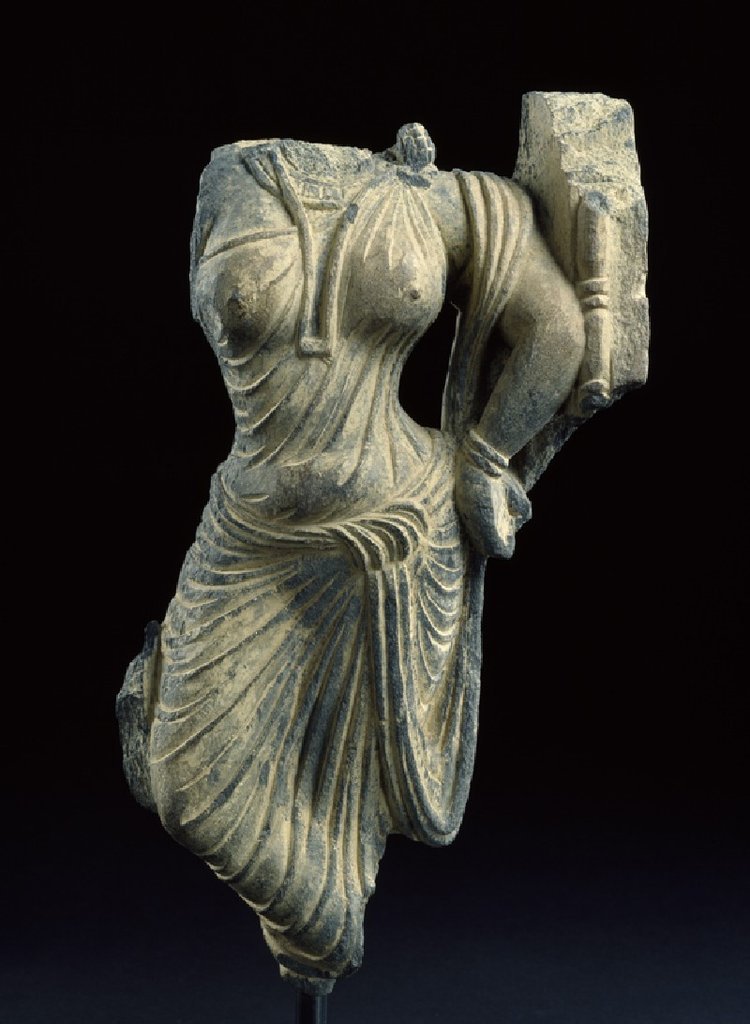Gandharan Art and Afghanistan
Detail of Head of the Buddha, c. AD 300-500, probably Taxila, Pakistan, stucco with polychrome, 29.2 cm (height), Victoria & Albert Museum, London (Image: V&A)
The territories of modern-day Afghanistan were a site of cross-fertilisation for centuries, in which many religious and cultural shifts took place. Afghanistan’s geographical location places it between Middle Eastern, South Asian and Central Asian cultures, particularly since it was so close to the Silk Road (the network of trade routes linking the Western world with the Middle East and Asia, active from the second century BCE until the mid-15th century). Gandhara was an ancient region comprised of what is now eastern Afghanistan and northwestern Pakistan (from around the sixth century BCE to the eleventh century CE). Alexander the Great’s conquest of the region in 327 BC had a huge impact on Gandharan art, which merged Greek and Buddhist visual cultures. The Golden Age of this art came during the Kushan Empire in the region (from the first century to the fifth century), and offers a reminder today of how the coming together of different cultures produces some of the most beautiful art.
Gandharan sculptures were among the first to portray Buddha in human form, as allowed by Mahayana Buddhism (which flourished in the Gandhara region). We can see the classical Greco-Roman influence in such depictions in the Standing Figure of Buddha, made around 200 CE and carved from grey stone called schist. His face closely resembles that of Apollo, and the naturalistic folds in his monk’s robes recall classical togas. In a temple context, this sculpture would have been painted and gilded; indeed, tiny flecks of gold can still be seen around the mouth and chin.
Standing Figure of Buddha, c. AD 200, Gandhara, grey schist, 95 cm (height), Ashmolean Museum, Oxford (Image: Ashmolean)
Another sculpture Head of the Buddha (made in the Gandhara region between 300-400 CE) might be compared with Marble Head of Athena (carved in ancient Greece around 200 BC). Both sculptures present highly stylised, symmetrical facial features and intricately woven hair. The lines and curves of the Gandharan sculpture seem bolder (although this, in part, will be due to the fact that it is less weathered), allowing the sculptor to emphasise Buddha’s attributes. The striking shadows cast by his eyebrows create two distinct curves, which clearly highlights the urna placed in the middle of his forehead (a signifier of his ability to see into the divine world). Similarly, the intricate waves of his hair (carved by hand) lead the eye upwards to his ushnisha (or topknot); a reminder of his warrior origins.
Head of the Buddha, c. AD 301-500, Gandhara, stucco with polychrome, 29.2 cm (height), Victoria & Albert Museum, London (Image: V&A)
Head of Athena, c. BC 200, Hellenistic era, Greece, marble, 48.26 cm (height), Met Museum, New York (Image: Met)
Of course, Gandharan sculptures not only depict the Buddha, but many different subject-matters. One remarkable statue shows a Bodhisattva - a compassionate Buddhist being who remains on earth until all beings achieve enlightenment. He is depicted as royalty, with jewels in his hair and flowing clothes wrapped elegantly around him. It is not only the naturalism of this statue that recalls Alexander the Great’s era in Gandhara: the plinth (on which the figure stands) also shows a small bodhisattva surrounded by four attendants and two Corinthian columns. In other works, even the smallest fragments are, in some ways, even more fascinating… Fragmentary Figure of a Mourner, for example, might have originally been part of a scene of the death of the Buddha. The figure’s dramatically curved posture, into a tight ‘C’ shape, conveys such tension and desperation in one small piece of stone, emphasised further by the details of his ribs and downturned face. The craftsmanship and sensitivity in textures and details draw viewers ever closer to these tiny relics of this ancient region.
During the Kushan period, huge statues of Buddha were constructed in monasteries and carved into hillsides. In recent years, Taliban forces have declared that such depictions are idolatrous and should be destroyed. The Buddha of Swat, carved on a cliff in the seventh century in the Pakistani Swat valley (once the ancient Uddiyana Kingdom, one of the most significant centres of Gandhara civilisation), was dynamited by the Pakistani Taliban in 2007. One local man and expert on Buddhism in Swat explained that it felt ‘like they killed my father… They attacked… my culture, my history’. Fortunately, the Buddha has since been restored, and acts as a powerful symbol of tolerance and resistance.
Fragmentary Figure of a Mourner, c. AD 101-300, Gandhara, schist, 11 cm (height), Ashmolean Museum, Oxford (Image: Ashmolean)
Hand Holding a Water Pot from an Image of Maitreya, c. AD 101-300, Gandhara, schist, 16.5 cm (height), British Museum, London (Image: British Museum)
Fragment of a Relief with Female Figure, c. AD 101-200, Gandhara, schist, 21.8 cm (height), Ashmolean Museum, Oxford (Image: Ashmolean)
In 2002, nine sculptural heads and a torso from 4th-century Gandhara were intercepted at Heathrow airport in the UK after a flight from Peshawar in Pakistan. The statues - most likely vandalised by the Taliban and intended for sale on the international black market - were sent to the British Museum to be conserved and catalogued, and sent back to the National Museum of Afghanistan in Kabul in 2019, in one of the most significant repatriation cases in the British Museum’s history. In an article at the time, the British Museum’s senior curator St John Simpson explained its poignant significance for the Kabul museum: ‘When you think what Kabul has been through since the 1990s, culminating in the atrocity of Bamiyan, this is a huge event.’ Upon their return, the artefacts were the stars of an exhibition at the National Museum.
Given the current context, looking back on this repatriation is even more poignant. Afghanistan is now under full Taliban control and international sanctions mean that more than twenty million Afghans are on the brink of famine (in what has become the world’s largest humanitarian crisis). The Taliban’s history of destroying Afghanistan’s cultural artefacts has left many fearful for Afghan artists and heritage: in 2001, an estimated 70% of the National Museum of Afghanistan’s collection was looted. The museum’s director, Mohammad Fahim Rahimi, explains: ‘it was the worst day of my life… I was ready to give my life for [the museum]’. Although there has not been a repeat performance since its recent reopening under Taliban control in November 2021, the museum staff (like all Afghan civil servants) have not received a salary since August, and the fate to Afghan’s cultural heritage remains to be seen. Recently, the United States has banned imports of Afghan antiquities, in an attempt to repress the illegal trading of these goods. However experts are concerned that the repatriation of such objects to the Taliban may result in their destruction.
‘A nation stays alive when its culture stays alive’. Now more than ever, it is important to remember these words of Paul Smith, former British Council Country Director of Afghanistan. Gandharan art is just one of countless examples of the cultural richness and diversity which characterises Afghanistan’s history - in sharp and poignant contrast to the country’s current state of turmoil.
(Written by Esme Garlake on behalf of Athena Art Foundation, March 2022)






